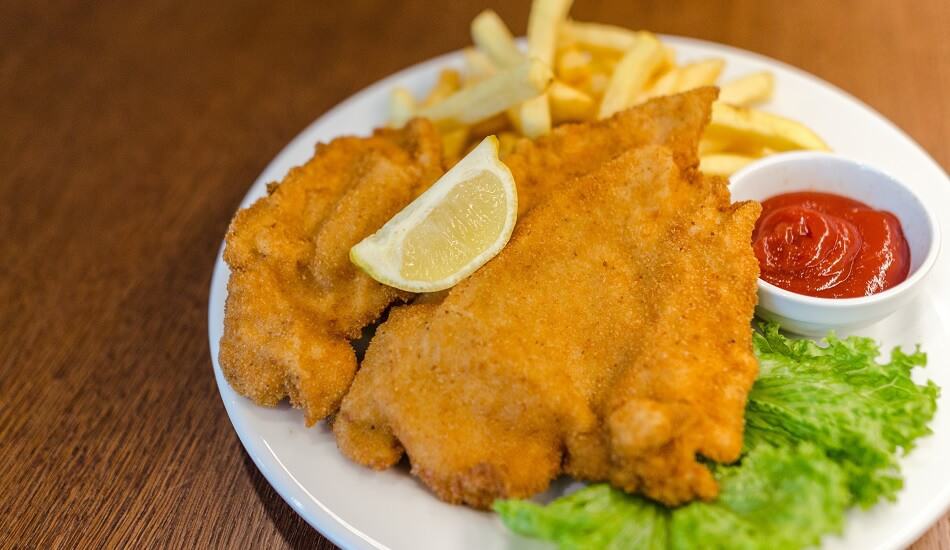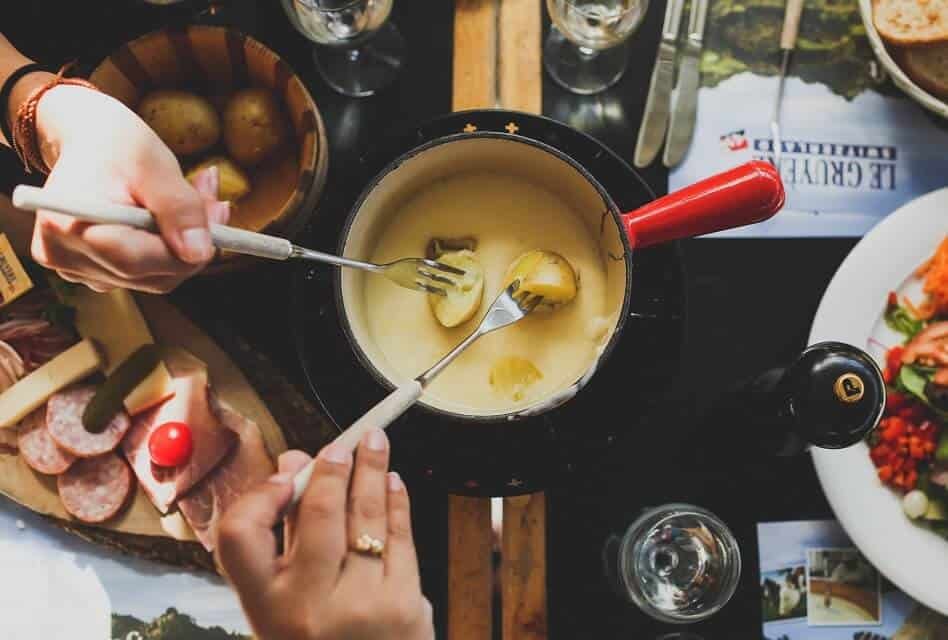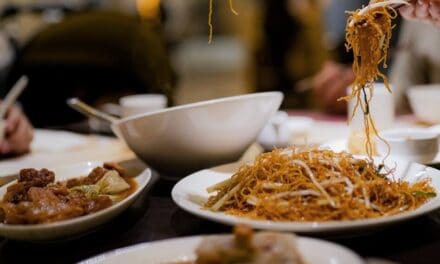Veal is a delicious alternative to beef, and you can find numerous fantastic veal dishes around the world. And like you can match beef and wine, you can create excellent veal and wine pairings.
If your veal dish is rather light, choose a white wine. For bolder dishes, choose red wine. Stay away from high-tannin wines but make sure the wine has enough acidity. Especially for complex meals like stews, acidity is key.
In the following paragraphs, we will discuss the most delicious veal and wine pairings:
- Veal Chops and Wine
- Veal Stew and Wine
- Saltimbocca and Wine
- Osso Buco and Wine
- Wiener Schnitzel and Wine
- Tafelspitz and Wine
- Veal Scallopini and Wine
But first, let us check why veal is special and define some basic wine and veal pairing rules.
WHAT IS VEAL?
Veal meat comes from young cattle, both cows and bulls. Just like beef, veal is very versatile, but it is perceivably softer and more tender. Because young cattle do not deliver much meat, veal is typically also more expensive than beef. Also, the risk of overcooking it is higher as it lacks fat. So it needs an experienced chef to prepare it.
Nevertheless, veal is a staple, particularly in European cuisines. The French, the Italians, and also the Germans and Austrians know many excellent veal dishes. This article will discuss the best meals and the right wines to pair with them.
BASIC RULES FOR PAIRING VEAL AND WINE
Pairing wine and veal can be challenging. The meat’s flavor differs based on the cut, and the preparation method and seasoning add even more complexity. Thus, it is impossible to recommend one wine that matches all veal dishes.
To find the right wine for your specific meal, consider these rules:
- Unlike many other red types of meat, veal can go very well with whites.
- If you choose red wine, make sure it is not too heavy. And the leaner your veal cut is, the lighter your wine pairing should be.
- Also, avoid high-tannin wines as they are too aggressive and will easily overpower veal dishes.
- The more complex the dish is, the more acidity your wine needs. That is particularly true for stews and ragouts as well as for creamy sauces.
- In contrast, pick low-acidity wines when you serve the meat in a tomato-based sauce. Otherwise, it will clash with the tomatoes’ acidity.
With these rules in mind, let us discuss some of the world’s best veal dishes and the best wines to match them.
Veal Chops and Wine
Veal chops are cuts from the loin. They are thick, contain a significant amount of fat, and typically come with bone attached. While you can boil and roast veal chops, grilling is arguably the best way to prepare them. It is important not to overcook them because they are prone to becoming very dry.
The high amount of fat makes veal chops incredibly juicy and flavorful. While gamey notes are common for the meat near the bone, you can add various aromas by applying the proper seasoning.
A dry red wine is the best pairing for veal chops. It needs to have a good body to stand the juicy, gamey meat. Red Zinfandel from California is just right. Its powerful fruit aromas complement the meat superbly, and when oaked, the wine contributes additional smokey notes.
Another option is Barbaresco. It is similarly bold and full of fruit flavors, but it will not overpower the chops because of its softer tannins.
Veal Stew and Wine
Stews and ragouts might be the veal dishes that are the hardest to pair with wine. The reason is that they come in numerous variations with all kinds of ingredients and, thus, wildly different flavor profiles. The ingredients might include potatoes, various vegetables, herbs, and spices. They are simmered together with the diced meat in water or stock over low heat. Many chefs also add wine or beer to add even more flavor.
The result is an incredibly flavorful dish with very tender meat. To match this dish, a white wine like Pinot Grigio is the right pick for you. Go for wines from Italy, or more specifically, the Friuli-Venezia Giulia or the Trentino-Alto Adige regions. They feature the right combination of body and acidity to deal with the stew’s complex flavor profile.
Red wine lovers should choose a red wine that is not too heavy. Pinot Noir is a fantastic option. Its fruity and earthy notes complement a rich stew deliciously, while its subtle tannins are not overly aggressive.
Saltimbocca and Wine
Italy is famous for its fantastic cuisine, and of course, the Italians have some excellent veal dishes as well. One of them is Saltimbocca. The name of this traditional meal from Rome derives from the words “salti in bocca”, meaning “jumps into the mouth”, which hints at its deliciousness.
The secret of Saltimbocca is Prosciutto, a cured Italian ham. It is wrapped around lean veal cutlets, which are then spiced with sage, pan-fried, and finally sautéed in white wine.
Naturally, a great Italian dish like Saltimbocca goes very well with red Italian wines. On the red side, Sangiovese is an excellent choice. It has the proper levels of body, tannins, and acidity to stand the juicy, flavorful meats, while its fruit and herbal notes complement them deliciously.

Raw Saltimbocca
Borreo by Silverado Vineyards Sangiovese 2018
- type: red, still, Vintage
- origin: United States, California
- varietal: Sangiovese
- alcohol: 14.2%
- type: red, still, Vintage
- origin: United States, California
- varietal: Sangiovese
- alcohol: 14.2%
- type: red, still, Vintage
- origin: United States, California
- varietal: Sangiovese
- alcohol: 13.9%
White wine lovers can find a matching wine from the Lazio region, for instance, a Frascati. This DOC-level wine is full-bodied with intense fruity and floral aromas. Make sure to get a dry variation. Alternatively, try a well-balanced Pinot Grigio.
Principe Pallavicini Frascati 2019
- type: white, still, Vintage
- origin: Italy, Lazio
- varietal: Greco, Malvasia, Trebbiano
- alcohol: 14.0%
Osso Buco and Wine
Osso Buco (also: Ossobuco) is another Italian veal specialty. Its home is the Lombardy region in the Northern part of the country. The name Osso Buco literally means “bone with a hole” and references the look of the cross-cut veal shank.
First, the meat is seared for a couple of minutes and then slowly braised in tomato sauce and white wine together with various vegetables. After about two hours of cooking, the meat is so tender that it falls off the bone. Italian chefs typically serve it with saffron risotto and top it with Gremolata, a green sauce made from lemon zest, minced garlic, and parsley.
Commonly, wine lovers pair Osso Buco with bold red wines such as Barolo. It can easily stand the rich meal. And with its high acidity level, it can cut through creamy side dishes such as risotto. Make sure to get an oak-aged style. Young Barolo often has too aggressive tannins that can clash with the tomato sauce’s acidity.
Paolo Conterno Barolo Ginestra 2016
- type: red, still, Vintage
- origin: Italy, Piedmont
- varietal: Nebbiolo
- alcohol: 15.5%
Marchesi di Barolo Barolo Sarmassa 2014
- type: red, still, Vintage
- origin: Italy, Piedmont
- varietal: Nebbiolo
- alcohol: 14.5%
Cordero di Montezemolo Barolo Enrico VI 2015
- type: red, still, Vintage
- origin: Italy, Piedmont
- varietal: Nebbiolo
- alcohol: 15.0%
Alternatively, you can pair Osso Buco with a Super Tuscan. This Sangiovese-dominated blends from the Tuscany region are also high in acidity and add intense fruity and earthy aromas to the flavor profile.
Tenuta Guado al Tasso Il Bruciato 2020
- type: red, still, Vintage
- origin: Italy, Tuscany
- varietal: Cabernet Sauvignon, Merlot, Syrah
- alcohol: 13.5%
Tenuta Le Colonne Bolgheri 2019
- type: red, still, Vintage
- origin: Italy, Tuscany
- varietal: Cabernet Franc, Merlot, Petit Verdot
- alcohol: 13.5%
- type: red, still, Vintage
- origin: Italy, Tuscany
- varietal: Cabernet Franc, Cabernet Sauvignon, Merlot
- alcohol: 14.5%
Wiener Schnitzel and Wine
Wiener Schnitzel (English: Viennese cutlet) might be the most famous dish from Austria, and it is also very popular in Germany. While you can often find pork preparations labeled “Schnitzel Wiener Art” (English: cutlet Vienna style) on restaurant menus, the original recipe calls for a lean veal cutlet.
The meat is seasoned with salt and pepper and then gets a thin breading. After searing it at high temperatures for a couple of minutes, its crust is golden-yellow, and the meal is ready to be served. Typically, it comes with a slice of lemon and either french fries, fried potatoes, or a potato salad.

Wiener Schnitzel with French Fries
The traditional wine pairing for Wiener Schnitzel is Grüner Veltliner. Look out for bottles from Niederösterreich (English: Lower Austria). These crisp white wines are just right to deal with the thin breading without overpowering the lean meat. Not every bottle is fine, though; you might perceive wines with too intense mineral or exotic notes as too dominant.
Weingut Alzinger Steinertal Smaragd Grüner Veltliner 2019
- type: white, still, Vintage
- origin: Austria, Wachau
- varietal: Grüner Veltliner
- alcohol: 13.5%
Pratsch Organic Grüner Veltliner 2020
- type: white, still, Vintage
- origin: Austria, Niederösterreich
- varietal: Grüner Veltliner
- alcohol: 12.5%
Schloss Gobelsburg Schlosskellerei Gobelsburger Grüner Veltliner 2020
- type: white, still, Vintage
- origin: Austria, Kamptal
- varietal: Grüner Veltliner
- alcohol: 12.5%
Another great option to pair with Wiener Schnitzel is Riesling. In particular wines from Germany tend to work very well with the Austrian dish.
Rebholz Von Rotliegenden Riesling Trocken 2020
- type: white, still, Vintage
- origin: Pfalz, Germany
- varietal: Riesling
- alcohol: 12.0%
Burklin-Wolf Pfalz Estate Riesling Trocken 2020
- type: white, still, Vintage
- origin: Pfalz, Germany
- varietal: Riesling
- alcohol: 12.0%
Von Winning Deidesheimer Paradiesgarten Riesling Erste Lage Trocken 2020
- type: white, still, Vintage
- origin: Pfalz, Germany
- varietal: Riesling
- alcohol: 12.0%
Tafelspitz and Wine
Speaking of Austrian cuisine, we should also discuss Tafelspitz. Like Wiener Schnitzel, the Tafelspitz recipe is more than 100 years old and comes in different variations. In this case, you can either use beef or veal.
The meat boils in a broth with various root vegetables and herbs for a few minutes and then simmer for one to two more hours. It’s served with potatoes, the boiled vegetables, and a creamy radish and apple sauce.
After two hours of simmering, the veal is tender and mellow and calls for white wine. Consider, for example, a Pinot Blanc from Germany. Usually, it is medium-acidic and offers delicious aromas of green and citrus fruits.
Salwey Estate Pinot Blanc 2019
- type: white, still, Vintage
- origin: Germany, Baden
- varietal: Pinot Blanc
- alcohol: 12.5%
Weingut Wagner Stempel Estate Pinot Blanc 2021
- type: white, still, Vintage
- origin: Germany, Rheinhessen
- varietal: Pinot Blanc
- alcohol: 12.5%
Weingut Friedrich Becker Pfalz Pinot Blanc 2021
- type: white, still, Vintage
- origin: Germany, Pfalz
- varietal: Pinot Blanc
- alcohol: 12.5%
The formerly mentioned Grüner Veltliner can work as well. Some wine lovers consider it too acidic to pair with the mellow veal, though.
Veal Scallopini and Wine
Let us get back to Italy again. There is one more dish worth discussing: Veal Scallopini. It is as common in Italy as Spaghetti or Pizza because it is easy to make but extremely flavorful.
Scallopini are small, thin cuts of veal that are very tender and soft. Chefs drench them in wheat flour and fry or sautée them in a redux sauce. Actually, the Italians use various types of sauce. The most popular are:
- piccata, a sauce made from butter, lemon juice, and capers
- tomato-wine redux
- mushroom-wine redux
Tomato-based preparations are great with Sangiovese wines. Pick a low-acidity wine, so it does not clash with the acidic tomatoes.
For Veal Scallopini with creamy mushroom sauces, you need quite the opposite: a high-acidity white wine. Pinot Grigios from the Friuli-Venezia Giulia or the Trentino-Alto Adige regions that we discussed before are perfect.
If you plan to serve Scallopini Piccata, you should open a bottle of dry rosé wine with it. Make sure it is not too light. Many wines from California and France will do the job, especially when featuring a combination of citrus, red berry, and herbal aromas.
La Bernarde Cotes de Provence Rose Les Hauts de Luc 2020
- type: rosé, still, Vintage
- origin: France, Provence
- varietal: Cinsault, Grenache, Mourvedre, Rolle, Syrah
- alcohol: 12.5%
- type: rosé, still, Vintage
- origin: France, Provence
- varietal: Carignan, Cinsault, Grenache
- alcohol: 13.0%
Mirabeau Cotes de Provence Rose 2020
- type: rosé, still, Vintage
- origin: France, Provence
- varietal: Cinsault, Grenache, Syrah
- alcohol: 13.0%
FINAL WORDS
Veal dishes are incredibly versatile, and most of them are fantastic. But they get even better if you pair them with a great bottle of wine. With the information from this article, you are for sure able to create the best veal and wine pairings.






